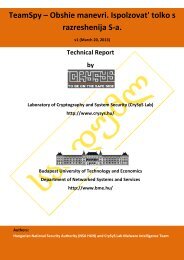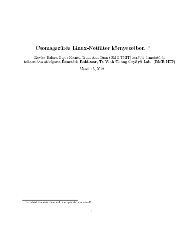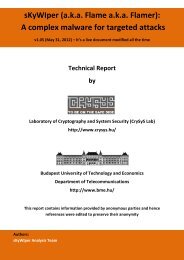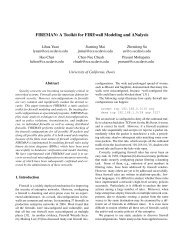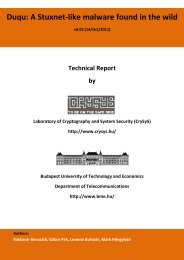Create successful ePaper yourself
Turn your PDF publications into a flip-book with our unique Google optimized e-Paper software.
y the vehicles. I also report on the results of an extensive simulation where I used my model to<br />
determine the level of privacy achieved in realistic scenarios. In particular, in my simulation, I used<br />
a rather complex road map, generated traffic with realistic parameters, and varied the strength<br />
of the adversary by varying the number of her monitoring points. My simulation results provide<br />
information about the relationship between the strength of the adversary and the level of privacy<br />
achieved by changing pseudonyms.<br />
From the first half of Chapter 3, it can be seen that untraceability of vehicles is an important<br />
requirement in future vehicle communications systems. Unfortunately, heartbeat messages used by<br />
many safety applications provide a constant stream of location data, and without any protection<br />
measures, they make tracking of vehicles easy even for a passive eavesdropper. However, considering<br />
a global attacker, this approach is effective only if some silent period is kept during the pseudonym<br />
change and several vehicles change their pseudonyms nearly at the same time and at the same<br />
location. Unlike other works that proposed explicit synchronization between a group of vehicles<br />
and/or required pseudonym change in a designated physical area (i.e., a static mix zone), I propose<br />
a much simpler approach that does not need any explicit cooperation between vehicles and any<br />
infrastructure support. My basic idea is that vehicles should not transmit heartbeat messages when<br />
their speed drops below a given threshold, and they should change pseudonym during each such<br />
silent period. This ensures that vehicles stopping at traffic lights or moving slowly in a traffic jam<br />
will all refrain from transmitting heartbeats and change their pseudonyms nearly at the same time<br />
and location. Thus, my scheme ensures both silent periods and synchronized pseudonym change<br />
in time and space, but it does so in an implicit way. I also argue that the risk of a fatal accident at<br />
a slow speed is low, and therefore, my scheme does not seriously impact safety-of-life. In addition,<br />
refraining from sending heartbeat messages when moving at low speed also relieves vehicles of the<br />
burden of verifying a potentially large amount of digital signatures, and thus, makes it possible to<br />
implement vehicle communications with less expensive equipments.<br />
In chapter 4, I propose protocols that increase the dependability of wireless sensor networks,<br />
which are potentially useful building blocks in cyber-physical systems. Wireless sensor networks<br />
can be used in many critical applications such as martial or critical infrastructure protection<br />
scenarios. In such a critical scenario, the dependability of the monitoring sensor network can be<br />
crucial. One interesting part of the dependability of a network, is how the network can hide its<br />
nodes with specific roles from an eavesdropping or active attacker.<br />
In this problem field, I propose protocols which can hide some important nodes of the network.<br />
More specifically, I propose two privacy preserving aggregator node election protocols, a privacy<br />
preserving data aggregation protocol, and a corresponding privacy preserving query protocol for<br />
sensor networks that allow for secure in-network data aggregation by making it difficult for an<br />
adversary to identify and then physically disable the designated aggregator nodes. The basic<br />
protocol can withstand a passive attacker, while my advanced protocols resist strong adversaries<br />
that can physically compromise some nodes. The privacy preserving aggregator protocol allows<br />
electing aggregator nodes within the network without leaking any information about the identity of<br />
the elected node. The privacy preserving aggregation protocol helps collecting data by the elected<br />
aggregator nodes without leaking the information, who is actually collecting the data. The privacy<br />
preserving query protocol enables an operator to collect the aggregated data from the unknown<br />
and anonymous aggregators without leaking the identity of the aggregating nodes.<br />
vi



